I always had and have a fascination with the early RC, RCA, and Cunningham tube boxes probably because they were the first and most common and easiest to find and buy starting in the mid 1970’s. As most collectors know, most tube shipping boxes are quite often harder to find in good condition than the tubes. The wording and designs were given to the box makers and in most cases were little works of art that had much to do with how well they sold to the public. The way they protected the tubes during shipment was also taken into consideration as well in their design. Protection meant that they may be a bit hard to get open but were only needed once. However, the eye-catching colors were soon forgotten as soon as the tubes arrived to the owners’ homes and quickly torn open with no regard for those boxes at all, thusly, there are more tubes than decent boxes. Etchings, decals, and paper tags on the tubes them-selves were also prominently displayed not only to ID them but as an advertising point.
One aspect when deciding to write this article on RCA and Cunningham boxes that was not immediantely apparent was which tube inner structure designs, etchings, etc., was which tubes were shipped in which boxes. Considering the quick changes in tube and box designs, this was not easy as I thought. Boxes must have been a fairly expensive so big changes meant a big outlay of money and time so General Electric, Westinghouse Lamp Company who made the early tubes for RCA and Cunningham and had to give this a bit of thought. I should guess that Cunningham designed his own colors and wording made this made it all the more complicated.
In the mid 1920,s, the Radio Corporation was the only legal maker of triode tubes in the US, and extended those rights to General Electric and Westinghouse Lamp Co., and Westinghouse Electric & Manufacturing Co. to make vacuum tubes for them. It is a fact that the US government considered this agreement with the Radio Corporation a matter of national security to form Radio Corporation of America. I will attempt to show, without perhaps being perfect, what tubes were shipped in what boxes and what they looked like up to the year 1925-26.
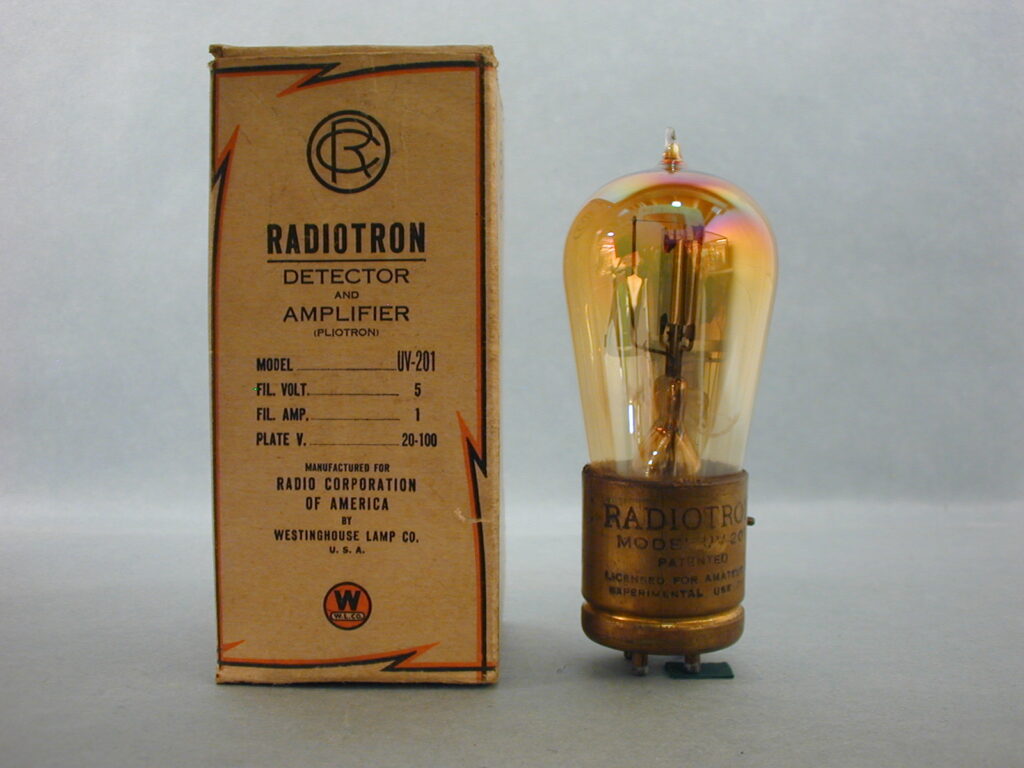
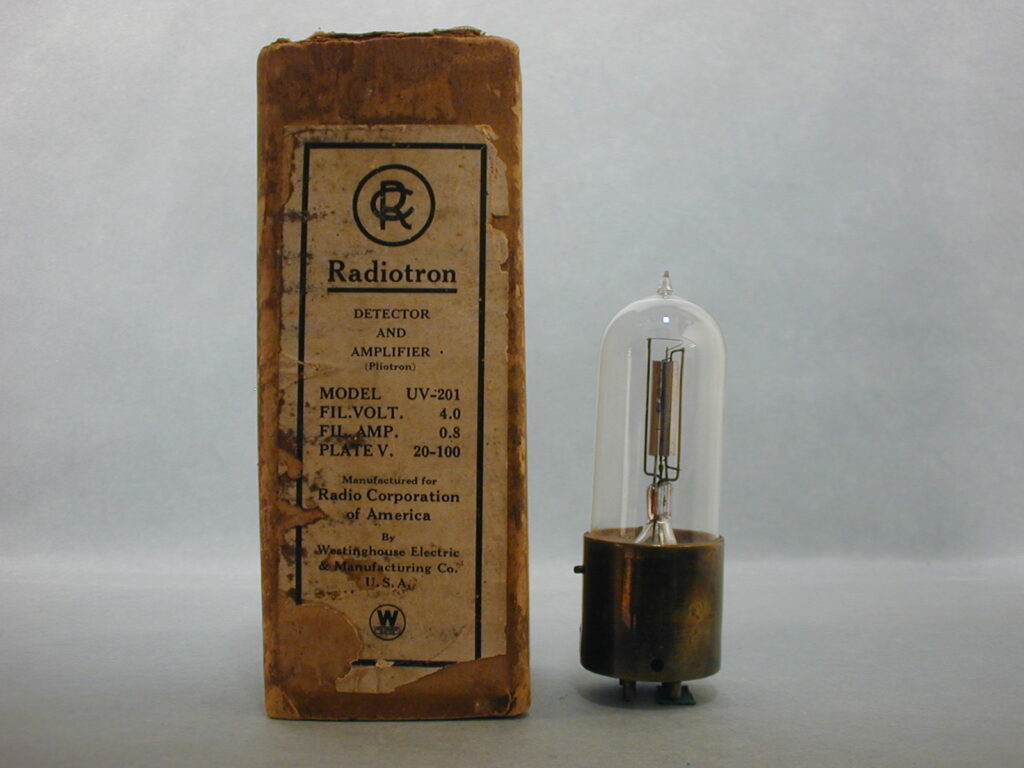
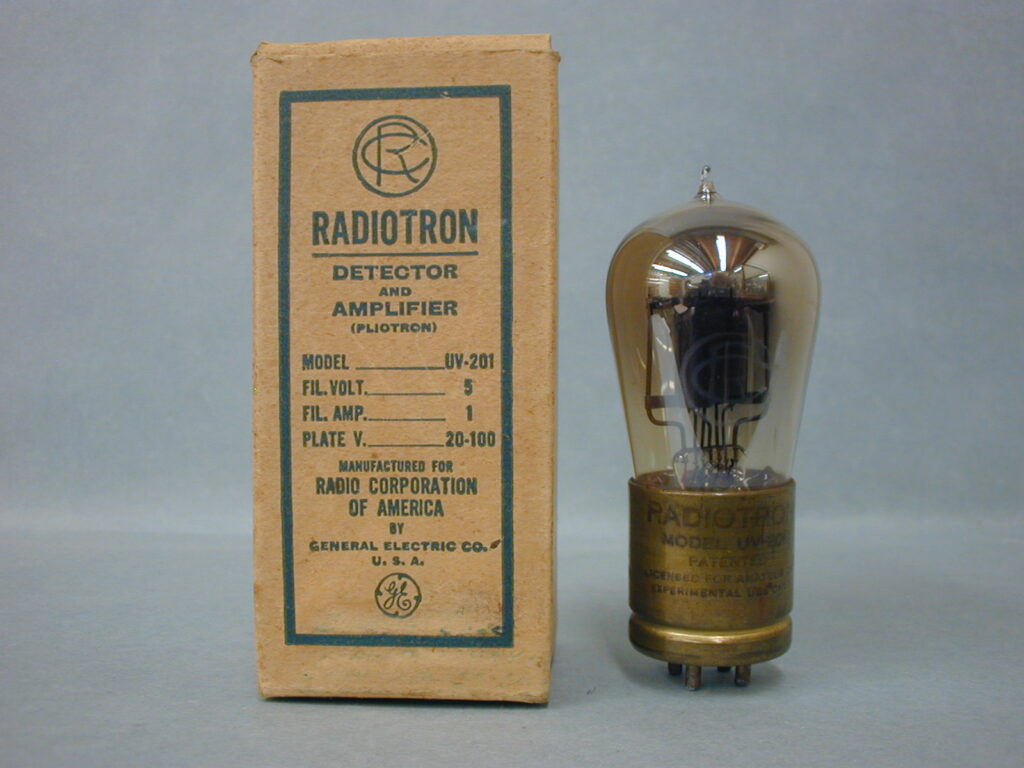
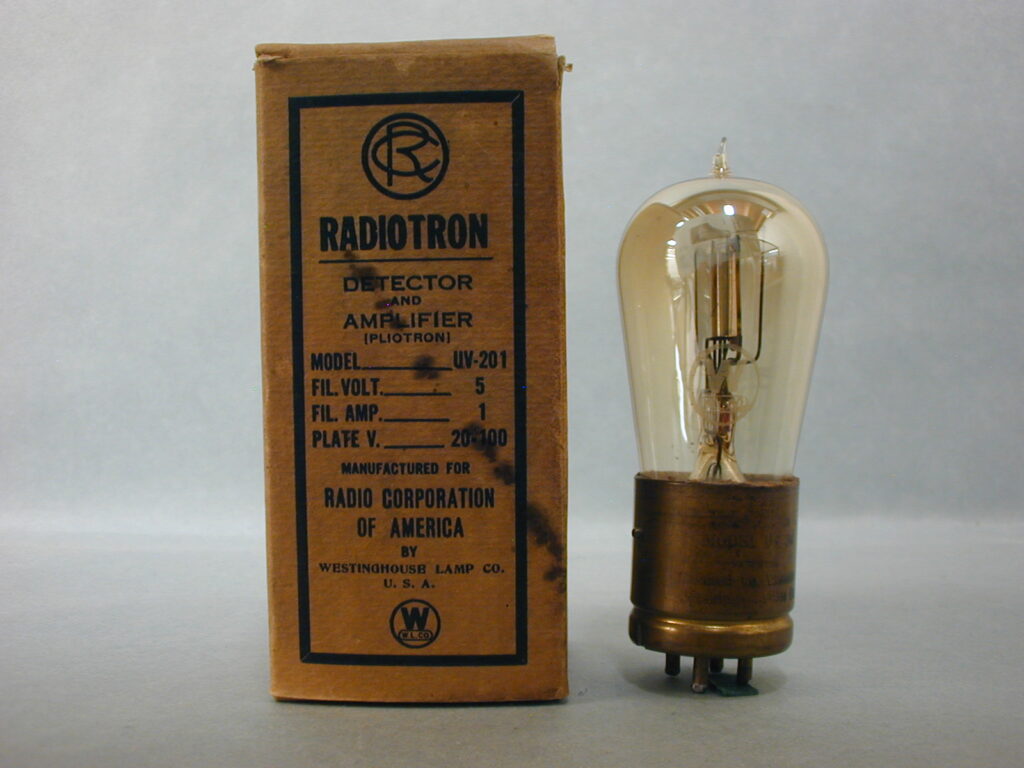
Fig. 1. This early UV 201 box was made by the Westinghouse Lamp Co., a division of General Electric Co. The RC in a circle stood for Radio Corporation of America which was later named RCA. The box design was never used again probably because it was rejected by G.E. RADIOTRON and Pliotron, below that, is inked on the base along with the word patented and a license disclosure on one side and manufactured for Radio Corporation of Amerca, UV 201 and Westinghouse Lamp Co. on the other. RC in a circle and a W and in smaller letters WLC are etched on the glass bulb. I suspect this type of Brass Based Tipped tube was supplied only in this style of box until the box design was changed. Judging by the rarity of the box and tube, it was used for very short time, perhaps just a few months.
Fig. 2. This box is a very early design made by Westinghouse Electric & Manufacturing Co. The wording on the label is similar to the box in fig. 1 in a different type of box. The outside stiff cardboard houses a slightly smaller slip in open to place the tube. The very unusual tube was unique to this box because of its specs. W E & M only made a few thousand of this UV 201 when it disappeared from the market. I wrote a special article about this tube and it can be found here to click on.: https://vacuumtubearchive.com/w-e-ms-uv-201-vacuum-tube/
Fig. 3. General Electric made this UV 201 box and tube for the Radio Corporation of America and this is stated on the box along with the GE logo and the words detector & amplifier. The RC in a circle is larger and more prominent. While not flashy, the blue lettering gets to the point perfectly in a classic way. The tube has RC and GE etched on the glass with the usual inked markings on the base. Studying the inner plate structure of this tube, it can be seen that four wings break away and attach to the two side supports. From that fact, I have never seen a tube etched RC in a UV 201 BBT not made in this manner. Other tube designs could have been shipped in this box at a later time so it depends on when they were made.
Fig. 4. Westinghouse Lamp Co. re-designed their box shown in fig. 1 to the box shown in fig. 4. Now the box looks more like G E’s box design. I cannot say how long WLC made this box but it took me around 25 years to find this example if that is any indication. The tube and box have the usual markings. The plate and overall tube design follows my thoughts mentioned in fig. 3.
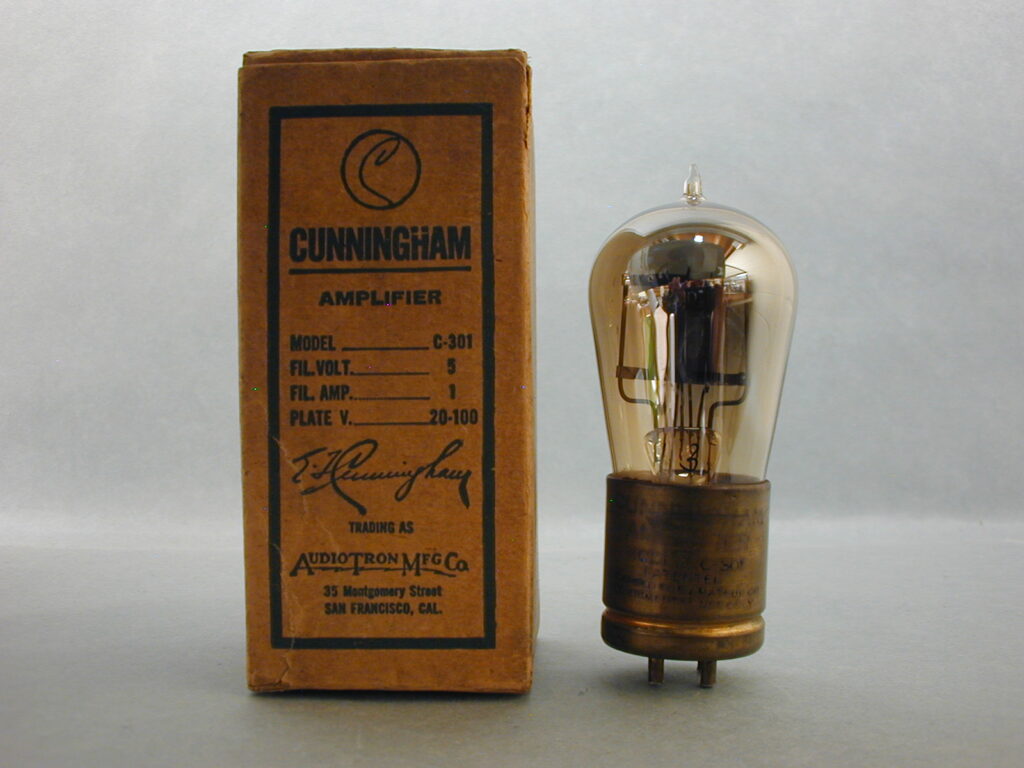
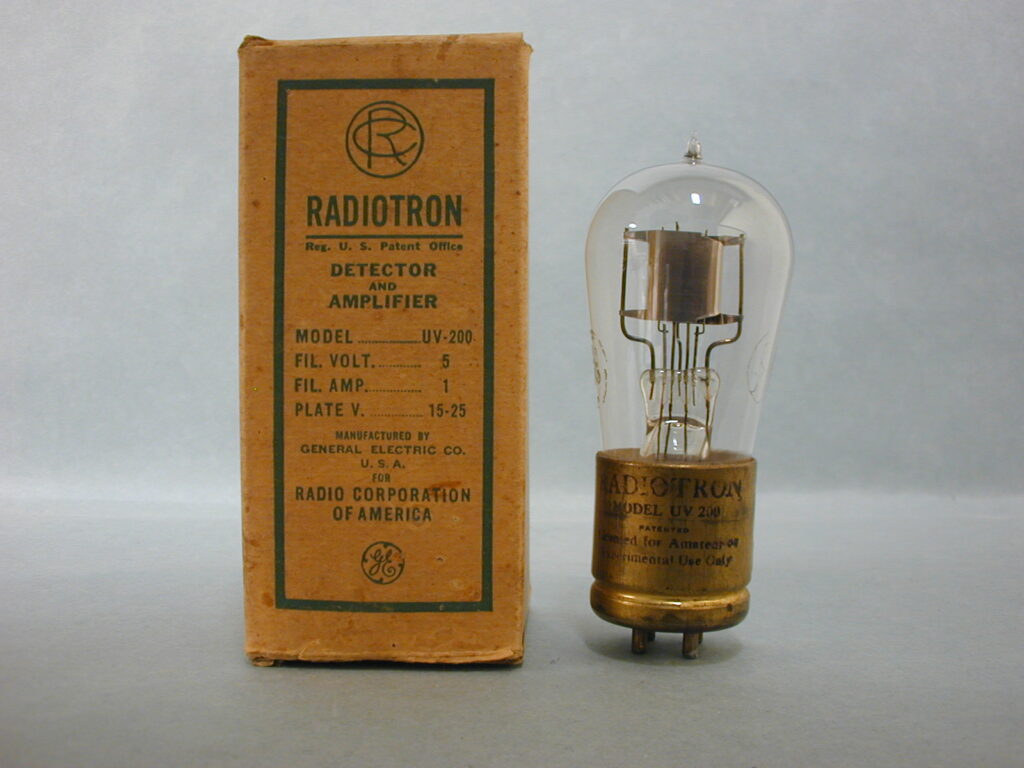
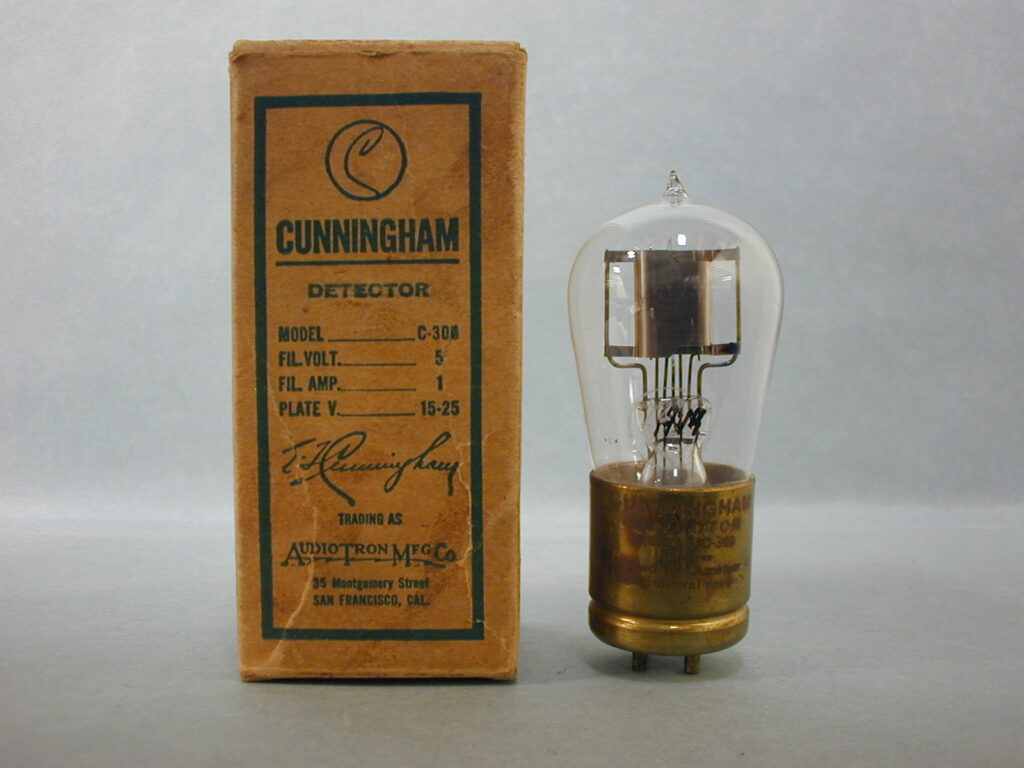
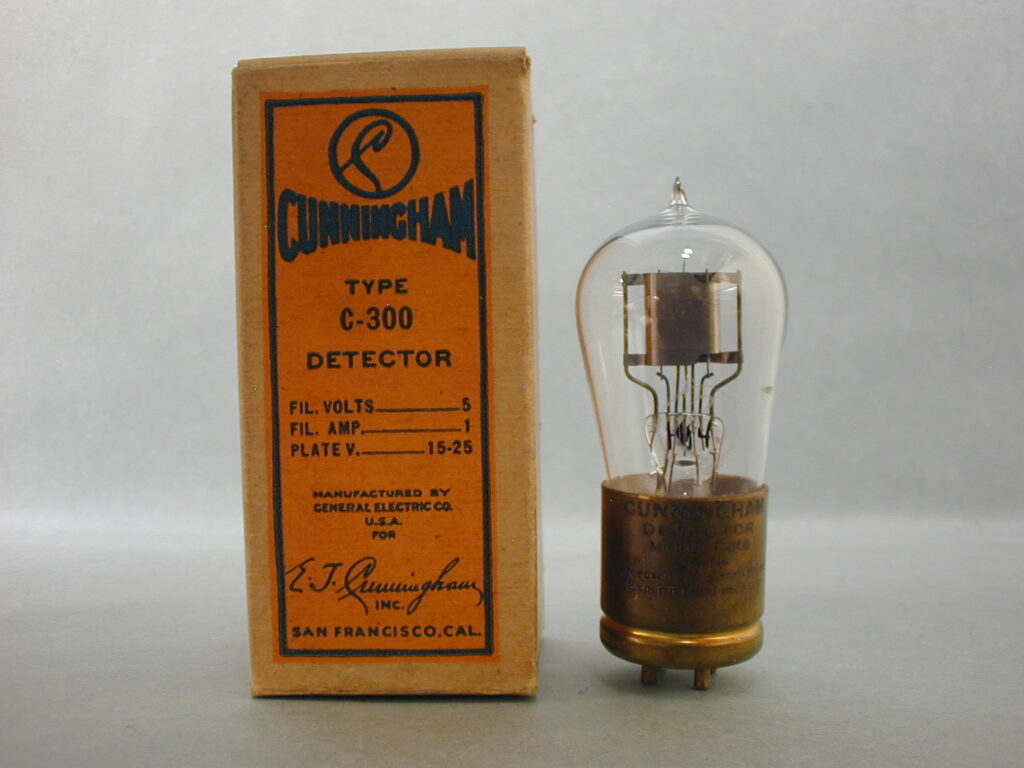
Fig. 5. Cunningham was the west coast sales rep for the Radio Corporation of America and his designed box is a bit different for his C-301. Cunningham seemed to have some power over RC as he must have insisted that his name, previous tube business name, and his street address be shown on the box. “E. T. Cunningham, Trading as Audiotron Mfg Co.”, C 301, and 35 Montgomery Street, San Francisco, Cal.” were added to the box. The word detector has been left off but amplifier still remains. This tells me that Cunningham wanted to have the box state what it was going to be used for. In this case as an amplifier. Audiotron Mfg Co refers to his on-going business of selling his tubular audiotron vacuum tubes. This type of box is certainly not common and only a small percentage were made and no future Cunningham boxes contained this wording. Otherwise, it does conform to the blue lettering and patent dates RC owned. I should guess that the tube itself has the same structured plate and this did not vary with another plate and overall tube designs as mentioned in fig. 3 above with some possible exceptions. The tube has the usual markings except for the etched C logo and RC on the glass, the name Cunningham, C301 on the base.
Fig. 6. Now we are moving on to the Radio Corporation of America UV 200 boxes. The printed words on them have been changed to green color and detector & amplifier have been retained as in the UV 01 series. RC and GE are still etched onto the glass bulb and the usual wording inked on the bases remained. I believe that the plate structure, 4 wings connected to the supports, of the tubes shipped in the boxes, remained consistent through this design with perhaps few exceptions as in the UV 01 series.
Fig. 7. The early C-300 box is shown here and again, the special wording, E. T Cunningham, Detector, and “Trading as Audiotron MFG. Co.” along with his address in San Francisco have been added, all in the green color. It is quite hard to come by and took many years to find in this decent condition. The C-300 tube has the usual etched C in a circle and GE. The base is similarly inked as the RC 200 in fig. 3 except for C-300. This particular tube is one of a pretty small number that I can say that it is truely unused. It seems, if my stock of Cunningham C-300 tubes is any indication, that GE made many more UV 200 and C-300 tube than 01’s, and in more varieties. Please refer to fig. 9 below.
Fig. 8. Cunningham now has a newly styled box that now states “Manufactured by General Electric Co.”. E.T. Cuningham is still present along with his address but now the Inc. has been added. GE may have insisted that he stop selling his tubular audiotron. I think the tube in the box was original and is the standard C-300 brass based tipped version but I should think that GE’s new plate design, machine blown glass bulb without the tip or even perhaps the bakelite base could just as well been in the box as well. those new designs would bring us up to 1925 standards. Again, refer to fig. 9 below.
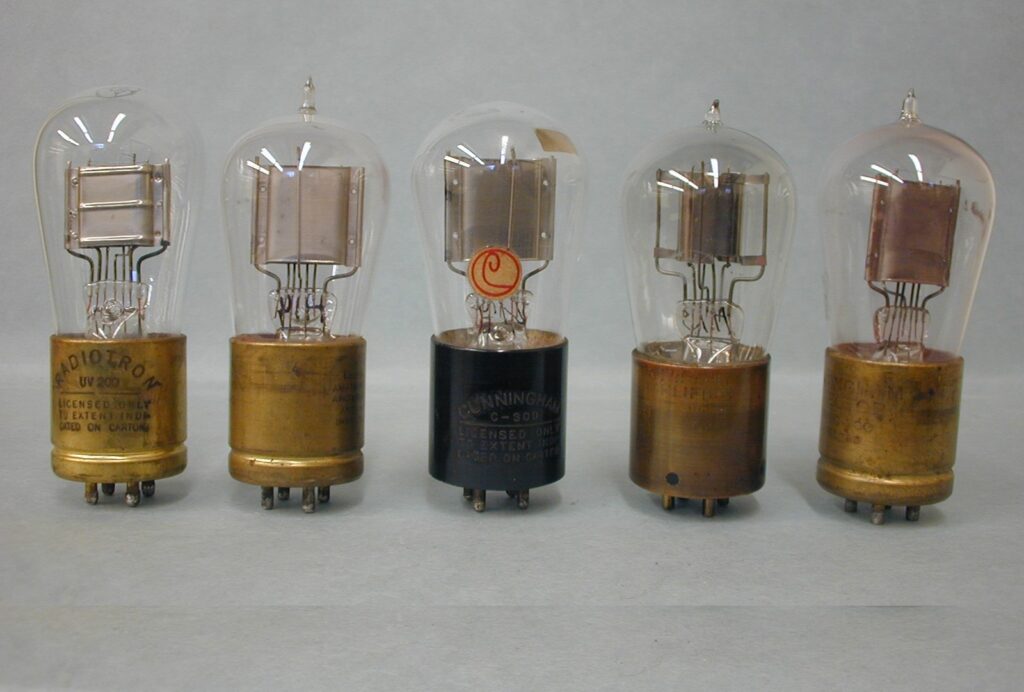
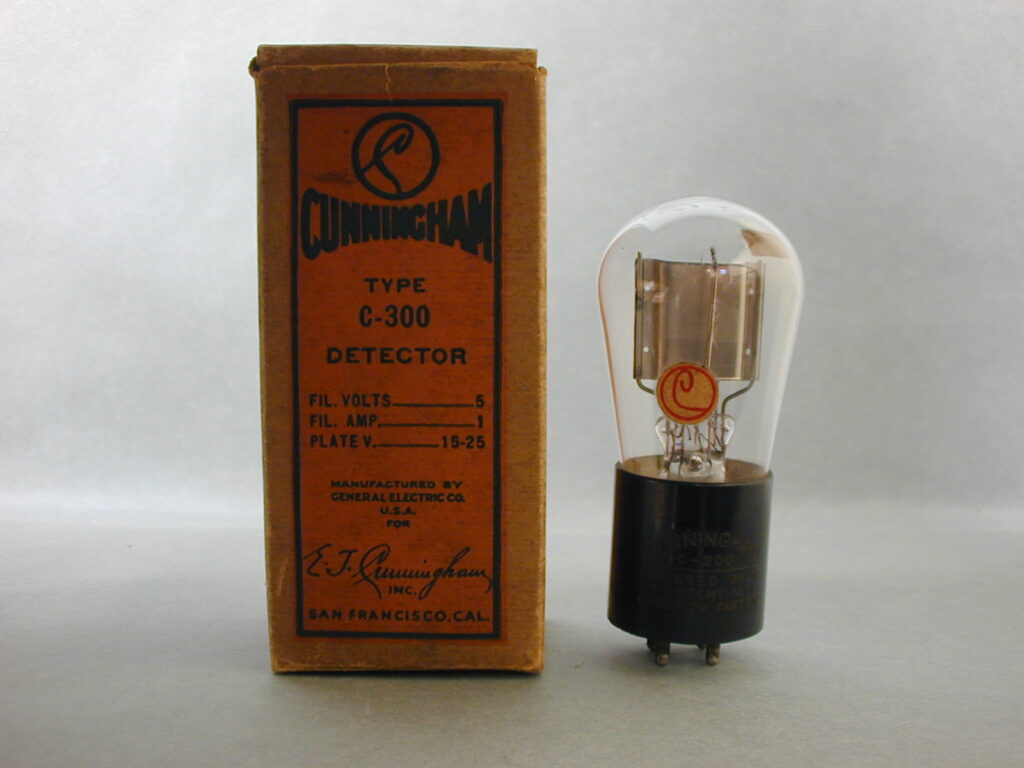
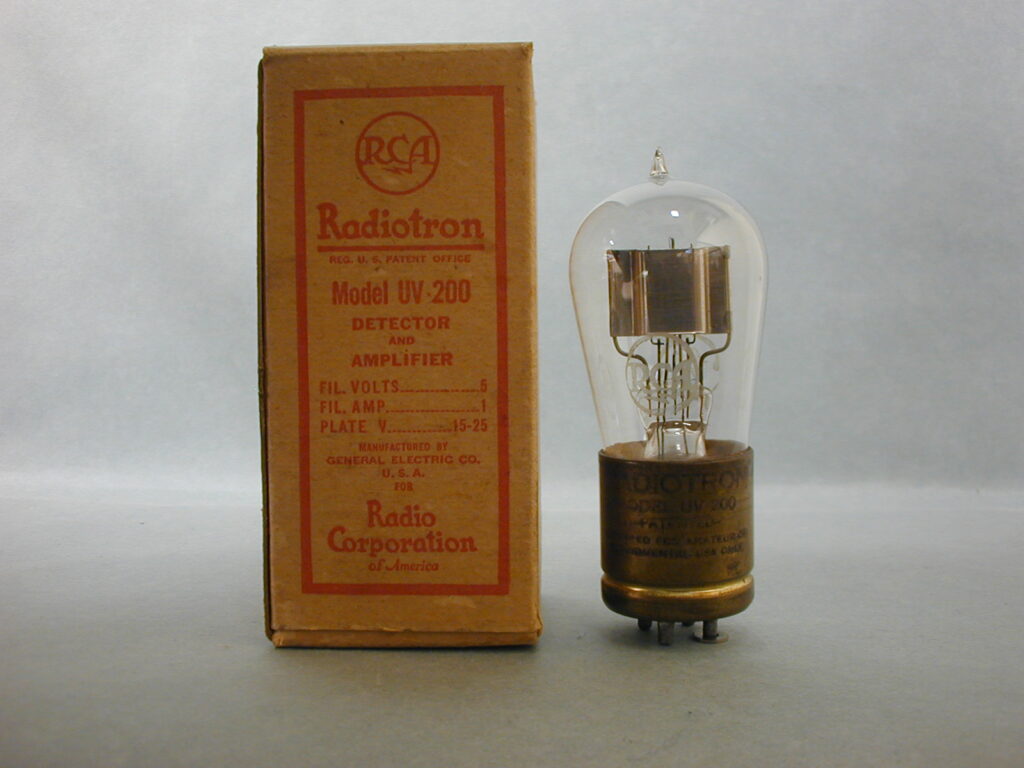
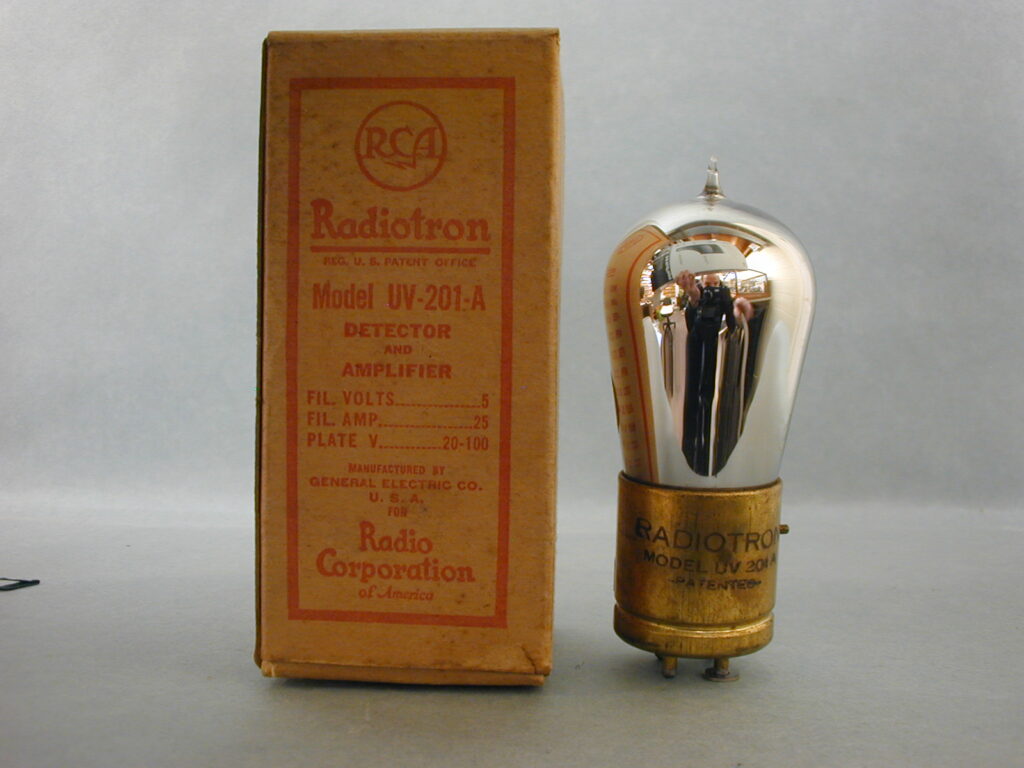
Fig. 9. RC UV 200 and Cunningham C-300 tubes came in a variety of styles including the 2nd from the right with a Shaw base. Any of these styles could have been in the boxes in all the pictures up to fig. 11.
Fig. 10. New artwork on this variety of a Cunningham C-300 box. It has the unused bakelite based tube and a machine blown glass bulb. It is perfectly fitting for this box to contain this style of tube.
Fig. 11. Radio Corporation of America changed its logo to RCA from RC. New red color letters is also a change along with new notice on one side. It states UV 200, however. The remaining info is much the same. I have never seen a UV 201 in this style box. Not to say they did not make one but I just never seen one. New style plate is also featured. As in most cases, no paper instructions came with the box. Etched on the glass bulb is RCA in a circle and the normal GE.
Fig. 12. A new line of boxes and tubes were designed called UV 201-A. The red color writing was maintained along with new logo. It can be a good guess that the new plate structure was in place on nearly all the UV 201-A’s but they could be brass base tipped, brass based machine made without a tip, or bakelite bases without a tip. Just so happens that the tube in my box was brass based tipped. See fig. 13 below for other forms of the tubes other than BBT’s.
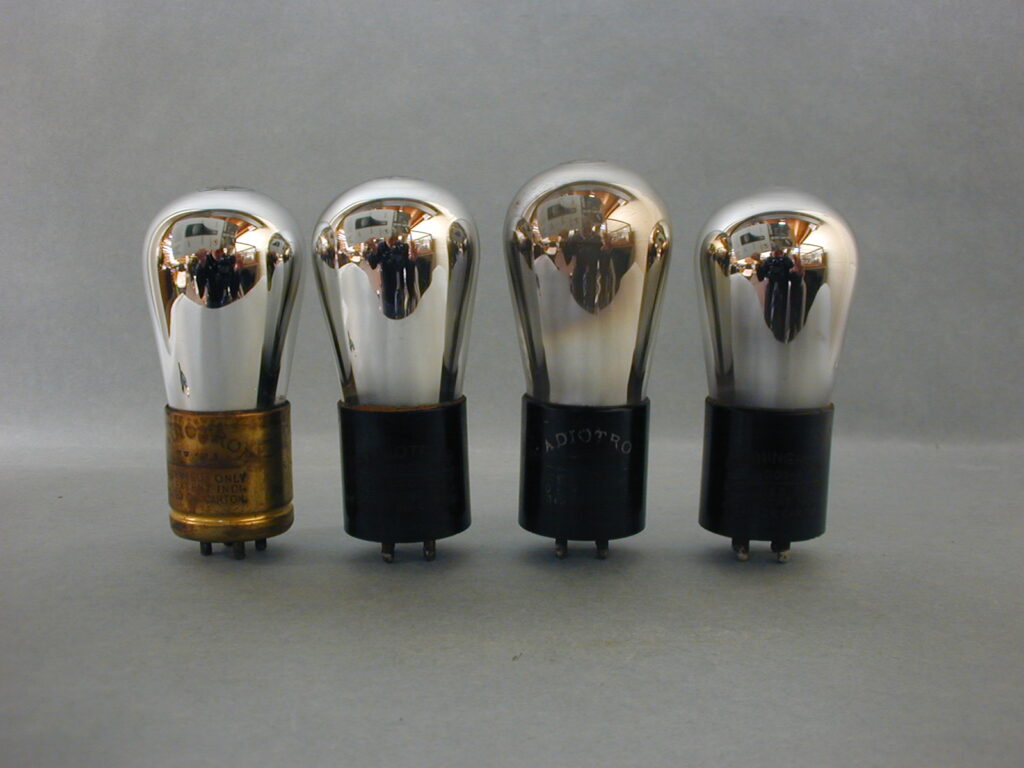
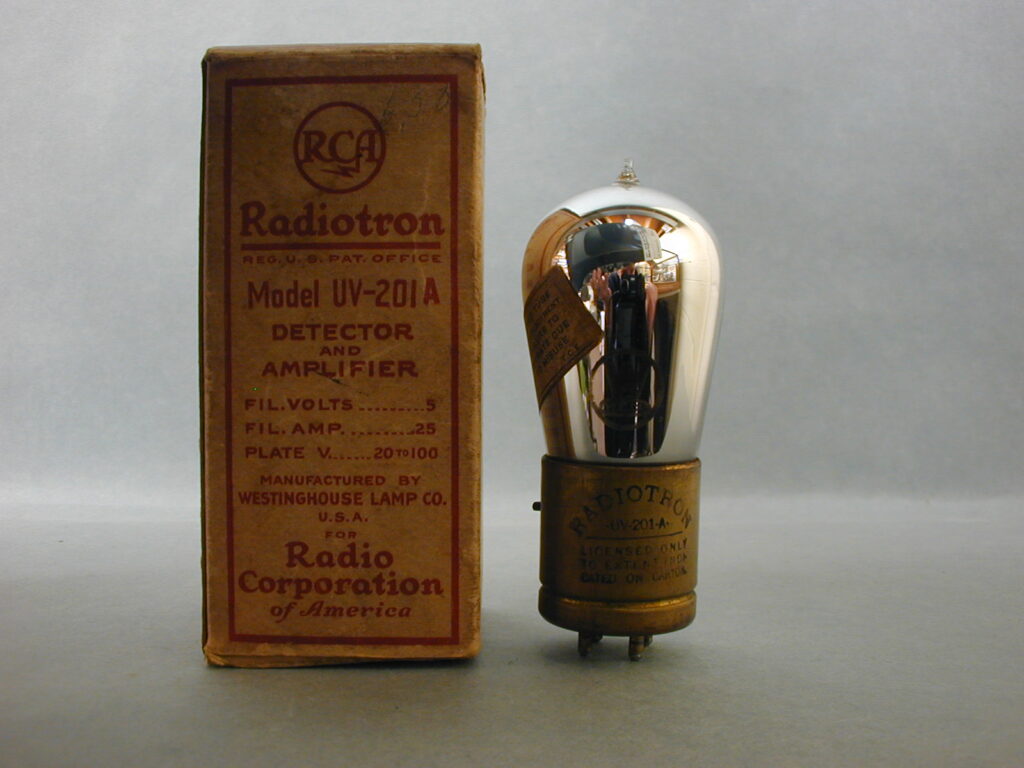
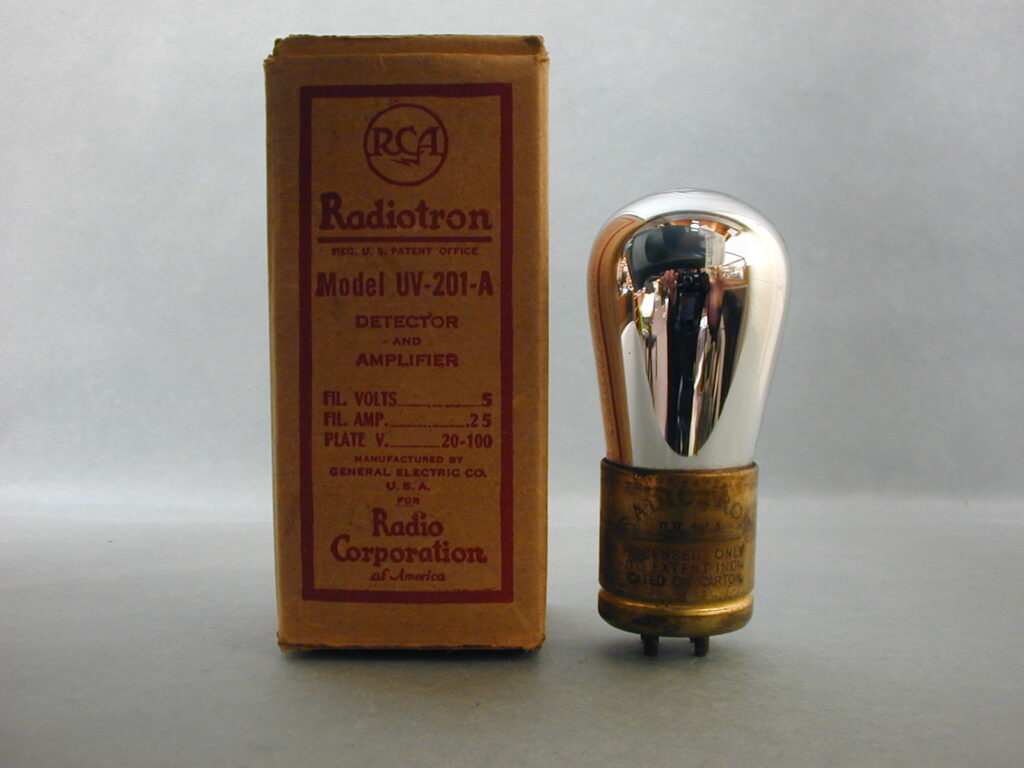
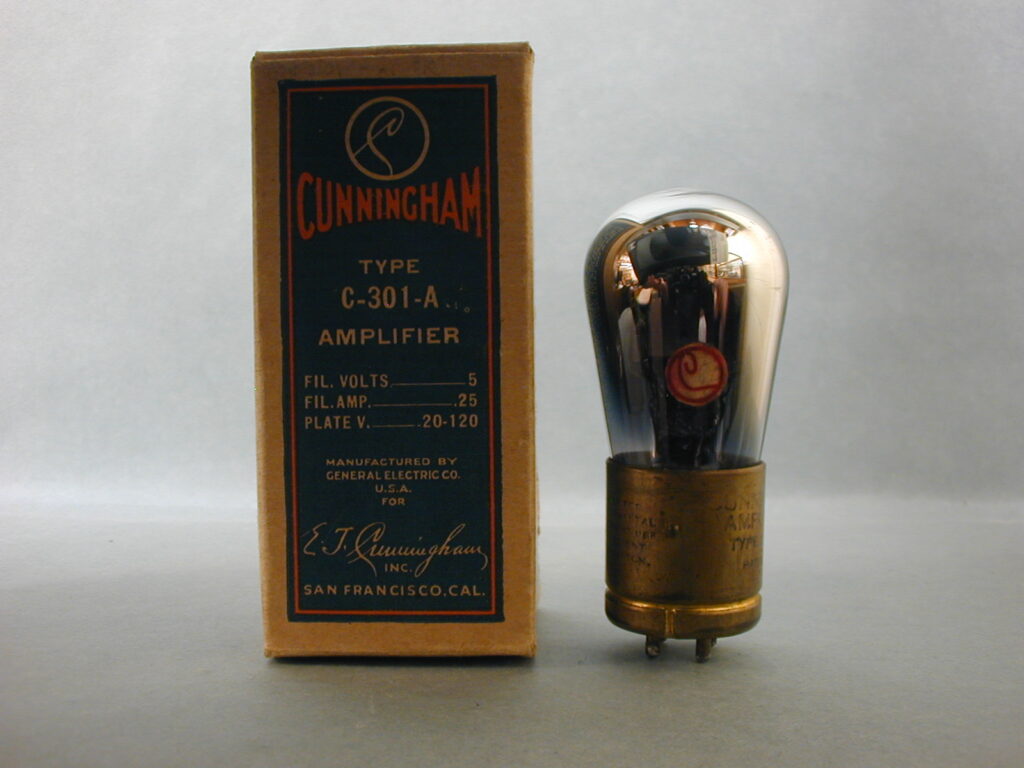
Fig. 13. There are 4 different styles of tube bases here. Three RCA Radiotrons and one Cunningham. These are to illustrate the different possibilities of what style of tube could be shipped in the RCA UV 201-A and Cunningham C-301-A boxes.
Fig. 14. This box was made by Westinghouse Lamp Co. The boxes are identical to the RCA boxes but the font size is a bit bigger. The brass based tipped UV 201-A Westinghouse tube now has the familiar logo but the inked base Radiotron is in a arch. Just a small change for an unknown reason. This tube could have had any of the RCA tubes placed in the shipping box.
Fig. 15. I only show this second RCA UV 201-A because I believe the box is a fake and the fake tube was enclosed in the box but I bought the box separate from the box. I presume the box is fake as I have not seen RCA use this Ohio maker on any other box? Cannot be certain about this.
Fig. 16. This box is identical to other Cunningham boxes but contains another variation of tube style– brass based but machine made glass bulb without the tip and with the new style plate.
That does it for this article but please advise me of any corrections that need to be made!!

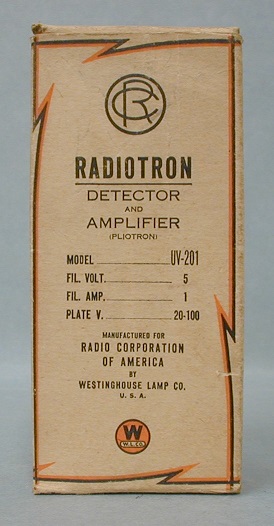
Leave a Reply